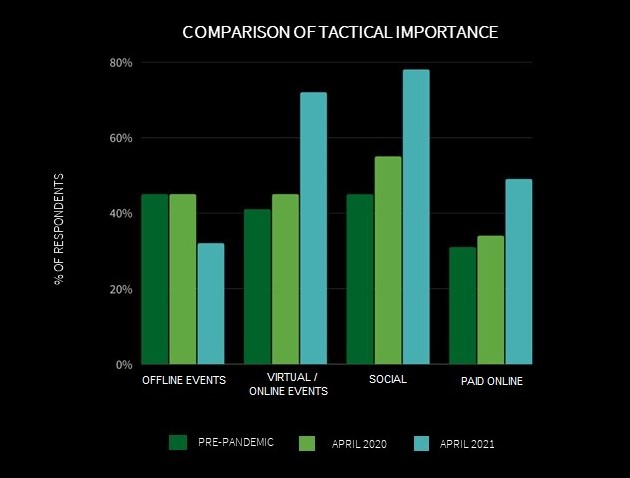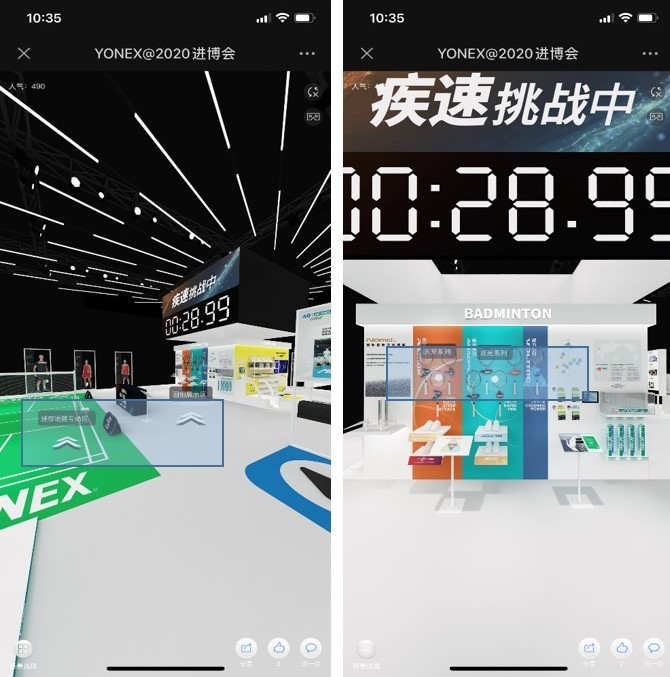
One Year On: How has the pandemic changed event and experiential marketing?
In 2020, the Pico Group conducted some client research to better understand how brands and marketers were reacting to COVID-19.
Then, during February-March 2021, we followed up with another client survey to find out what had fundamentally changed in event and experiential marketing, how well equipped are professionals to deal with challenges, and where brands are seeing success and room to improve.
Respondents included executives (11%), directors (31%), managers (46%) and other titles (12%) from a wide variety of industries across Asia Pacific (65%), Europe (19%), North America (13%) and the Middle East/North Africa (3%). The results show a clear sea-change in current market sentiment toward the post-pandemic era.
As expected, respondents rated virtual/online events more highly in 2021 than they did the year before: 71% deemed them ‘very’ or ‘extremely’ important, a year-on-year increase of 26 percentage points. Over 90% said they have held or are considering hybrid events, while just 32% said offline or live events were ‘very’ or ‘extremely’ important (2020: 45%).

Implications for the future
The heightened level of tactical importance for virtual and hybrid events revealed by the 2021 survey makes it obvious that those formats will further establish themselves as the norm in the short term. Indeed, considering the pace of economic recovery and vaccination in much of the world, physical events are almost certain to remain the exception rather than the rule for many markets.
However, we believe the perceived value of offline events is still strong because of the uniqueness of what they offer audiences. Their intimacy, sensory stimulation and emotion are hard to recreate digitally. When we quizzed respondents about critical success factors for virtual events, over 70% said ‘interactivity’ and ‘personalisation’.
When you look through the lens of ‘experience’, you can start to better understand the appeal of live events – and the challenges marketers face. But for now, with so many brands still looking at virtual events or planning hybrid ones, what can we learn?
1. The pitfalls of technology-driven experiences
Opportunities certainly exist for brands and their agencies to do better in this space. While deciding the technology in advance is not necessarily the wrong approach, it does impose limitations on what is possible. That is, the virtual event experience needs to work within the constraints of the platform and its functionality.
The Infinity-Pico team’s recent MARKies Award-winning work on HP Inc. Malaysia’s launch and partner event − ‘Creators of Tomorrow’ challenged the concept of a virtual event to its very roots. Taking a content-driven approach, they designed an experience that used AR to allow viewers to interact with the product launch stream. Avatars were also created to personalise the experience for channel partners and make them part of the stream. The overall technical solution then followed the content’s lead.
There are opportunities for marketers to improve upon what they are doing by taking a more experience-led approach to virtual activity. They just need to be open to integrating ‘best of the breed’ solutions for individual components. By not locking yourself into a technology upfront, you will not be cornered into compromising on delivering the best audience experience possible.
2. The important intersection of offline and online
With more than 90% of respondents saying that they have held or are planning to hold hybrid events, interactivity and personalisation become even more important considerations. This is especially true when an event’s online and live elements sit side-by-side.
The streaming of a live keynote or launch via social media goes only part of the way to delivering a powerful hybrid event. Hybrid activity also looks at the intersection of offline and online and how it works from an experiential perspective. For example, if a brand has edutainment experiences at the live site, creating a digital twin that people can experience online makes a hybrid ‘intersection’ – and one that delivers on a singular objective.
In a similar vein, another ‘intersection’ is created when catering for one-to-one or one-to-few meetings whose participants are in far-flung physical locations. Here, the challenge is in making it feel like a ‘whole experience’.
What does a hybrid intersection look like?
Pico took a hybrid approach for Yonex’s participation in the third China International Import Expo (CIIE), aiming to help the brand engage with a broader audience not solely comprised of the Expo’s usual industry visitors. By creating a digital twin of the live activation through which audiences could enter a virtual Yonex booth via the brand’s WeChat channel, the brand was able to engage a consumer audience as well.
Inside the virtual booth, the latest product information and ‘buy now’ options that linked to Yonex’s flagship store on the JD.com e-commerce platform were embedded in the environment to replicate the physical Yonex booth experience at CIIE.
While utilising WeChat to engage with the online audience, the brand could also leverage owned and paid media to push notifications and ads to them. A hybrid intersection of Lin Dan’s ambassadorship was created by livestreaming his interaction with the offline audience on five platforms. It resulted in a strong engagement and ROI.
Put simply, the experience within this hybrid ‘intersection’ allowed Yonex to optimise their investment beyond the trade show floor.

3. Better use of data in experiential marketing
Though many of the survey respondents were using data for retargeting/remarketing (59%) or analytics such as customer segmentation (52%) or campaign optimisation (45%), 65% said they were still grappling with capturing the right data to measure the ROI of virtual or hybrid events.
Given their digital nature, there is a lot of opportunity to unlock the value of data within virtual or hybrid events. What can be improved?
- Plan to capture more of the right data: Having a data planner input at the beginning ensures that the experience will also aim to capture the right data. This may also allow brands to capture new forms of data, such as behavioural or interest-level data, for ROI measurement.
- Use data to create better experiences: With technologies such as ‘recommendation engines’ becoming mainstream, we will begin to see more programmatic approaches to experiential; approaches where data is personalising the experience, online or offline.
Conclusion
Allied Market Research projects that the event industry will rake in US$1,552.9 billion globally by 2028. While this may very well turn out to be accurate, the question remains of how big a slice of that pie will derive from virtual and hybrid events.
The ultimate deciding factor of success for any virtual and hybrid event is the same as that of physical events: human experience. For the next few years, it will also determine the future of event and experiential marketing.
For more insights, read the full research report - available to you at no cost. Click here to request a report.